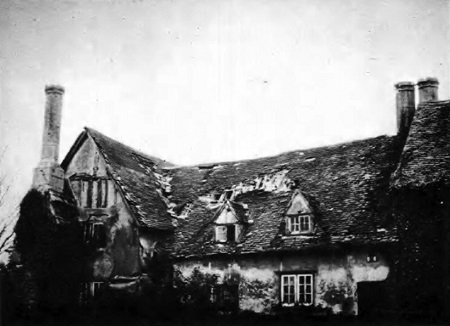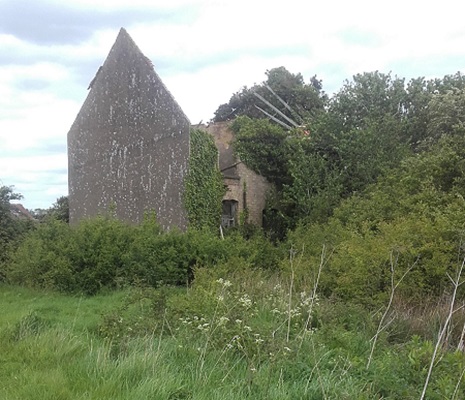Crowhill Farm, Bolnhurst
This article was written by Pamela Hider.
 Crowhill Farm, the medieval building from the north, 1973. (Reproduced from the Bedfordshire Archaeological Journal Vol.12, p.77, plate 1a).
Crowhill Farm, the medieval building from the north, 1973. (Reproduced from the Bedfordshire Archaeological Journal Vol.12, p.77, plate 1a).
The derelict house and buildings of Crowhill Farm lie just half a mile across fields south west of Bolnhurst Church.
The Historic Environment Record for Bedfordshire describes Crowhill Farm as follows:
"Farmhouse, timber-framed, with tiled roof. Originally a late medieval hall-house, probably built c.1500. Additions and alterations were made during the 16th century. A new west end was added in the mid to late 19th century. The farm is recorded from at least 1537. It was formerly known as Moore's Farm, and was owned by the Moore family from 1541 to 1592. It was owned by the Francklin family from 1592 until 1944, and occupied by tenant farmers".
'The first house was a late medieval hall-house with services at one end and a two storey wing at the opposite end, all probably dating from the same time, c. 1500 or a little later. Subsequently, the hall was floored-over and a smoke-bay constructed, probably by Richard Moore, 1541-47. Later still a stone stack was inserted in the smoke-bay and a stack added to the wing, probably by Robert Moore, 1557-84. The present roof to the main range may date from c.1600. A new west end was added, in place of the former services, in the mid-to-late nineteenth century, and there have been subsequent minor alterations'. [1]
Richard Moore, who purchased the farm in 1541, was a prosperous farmer from neighbouring Colmworth, whose sons inherited the farm. Robert Moore was the owner in 1557 and his prosperity is evident from his Will of 1584 which listed items of silver and gold and household items which showed how comfortably the family lived. One of his sons went to Cambridge University and four other sons received a farm each. Towards the end of his life, he leased some of his lands to the Francklins of Bolnhurst and by 1592, George Francklin had purchased the lands of Moore's Farm.
The last Francklin tenant was Frank Thomas Holley, who moved there in 1934 with his parents and brother. Electoral Rolls show that 1957 was the last year in which Crowhill Farm appeared in the record. It would seem then that it was around that time when it became unoccupied and subsequently derelict. In an article for a local magazine [2], Frank was interviewed and gave a description of the "..late medieval hall house, which has seven bedrooms (several of which were entered by stepping over high beams), two staircases and one or two rooms with seating built all round the walls, which had probably been the 'servants' halls'...Frank remembers that when they first arrived at Crowhill, the only source of household water was a well in a neighbouring field. Soon, however, another well was dug nearer the house and a rotary pump installed in the kitchen. Frank, his father and brother, Henry, did all the work of the farm with the help of only one other farmworker, a man with the unusual name of Leeson Folbigg, who lived in a cottage which stood until some years ago beside the brook near the Nag's Head" (Z1401/5/10).
The Francklin Estate of 5 freehold farms (800 acres) had been sold in 1944 by auction (PK2/2/544) to George Pell of Wilden. This marked the closing of a tenure by the same family of almost four centuries, and the following year, the Francklin family records were deposited in our Archives. This extensive documentation (FN series) allows a detailed study of the tenurial history of the farm, which for 300 years was known as Moore's Farm. The records do not designate the name 'Crowhill Farm' until an estate map of 1858, though it appears as such on the OS map of 1835.
Memories of Crowhill Farm
'Whitsun weekend 1943 saw the Biggleswade Scout Troop in camp at Crowhill Farm between Bolnhurst and Thurleigh. The nearby Thurleigh airfield was occupied by the 306th Bombardment Group of the United States 8th Army Air Force. Each morning we Scouts were awoken by the sound of the Wright Cyclone engines being warmed up and just before breakfast the B17 Flying Fortresses were passing overhead on their way to targets in Europe, usually returning by mid to late afternoon'. [3]
Looking at the derelict remains today, is to look at the history of a building that witnessed life from the Tudor period through to post World War II.
 Crowhill Farm 2022
Crowhill Farm 2022
1] Crowhill Farm, Bolnhurst, Bedfordshire: A Timber-Framed Building and its History by David H. Kennett and Terence Paul Smith. From the Bedfordshire Archaeological Journal Vol.12, 1977.
[2] Village Voice Magazine for Bolnhurst & Keysoe, 1987
[3] Memoriesof a Biggleswade Boy by Eric James Lund.